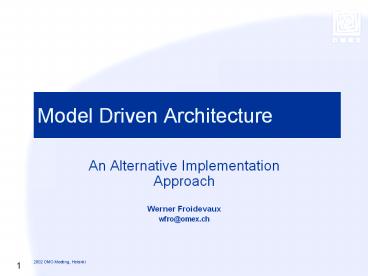Model Driven Architecture - PowerPoint PPT Presentation
Title:
Model Driven Architecture
Description:
... to PIMs requires a platform-independent concept of a component. 10 ... Platform-independent language bindings ... Portable, platform-independent components. ... – PowerPoint PPT presentation
Number of Views:122
Avg rating:3.0/5.0
Title: Model Driven Architecture
1
Model Driven Architecture
- An Alternative Implementation Approach
- Werner Froidevaux
- wfro_at_omex.ch
2
Generating Implementations
Platform-Independent Model
MDA tool applies a standard mapping to generate
Platform-Specific Model (PSM) from the PIM. Code
is partially automatic, partially hand-written.
XML/SOAPModel
OtherModel
CORBA Model
Java/EJBModel
Map PSM to application interfaces, code, GUI
descriptors, SQL queries, etc.
MDA Tool generates all or most of the
implementation code for deployment technology
selected by the developer.
XML/SOAP
Other
CORBA
Java/EJB
3
Benefit of MDA
- Generators accelerate component development
typically by orders of magnitude compared to
manual implementation - and many more
- BUT
4
B U T
- effective code generation requires UML
extensions. Vendors have defined proprietary
dialects of UML, standard dialects are appearing
(e.g. Web Application Extension (WAE), UML
Profile for EJB (JCP JSR-26)) - tools generate platform-specific bindings (e.g.
CORBA-, EJB-, WebServices bindings)
- vendor-specific, non-portable models
- non-interoperable applications
- non-portable application-code
5
MDA The Modeling Babylon?
- NO. MDA already speaks Esperanto
Q How much platform-specific modeling is
required?
A None.
A Very few. Only PIM mappings.
Q How much code generation is required?
6
Joking?
- NO. It already has been shown that
platform-specific modeling is not really
required - Proven in several years of experience with
extensive use of MOF, UML, XMI in customer
projects. Started with prototype implementation
and presentation 'MOF compliant IFR' _at_ 1999 OMG
Meeting, Philadelphia. - and other (UML-VM by Dirk Riehle),
7
The MOF IFR Prototype _at_ 1999
- Extensive use of code generators (PIM and PSM)
GUI Generator
Implementation Generator
Rose Exporter
MOF Repository
XML Exporter/ Importer
IDL Generator
Component
MOF Generator Toolset
8
Lessons Learned
- 1 PSMs are not required.
- 2 Let PIM be part of runtime environment.
- 3 Separate client-binding from server-binding.
9
1-1 PSMs are not required
- PIMs are standardized and portable. E.g. MOF, UML
without extensions. - PSMs are typically proprietary and non-portable.
The restriction to PIMs requires a
platform-independent concept of a component.
10
1-2 PSMs are not required
- What is a platform-independent component?
- Required
- platform-independent language bindings
- platform-independent component model and
deployment - abstraction from the middleware
- Optional
- abstraction from programming language
11
1-3 PSMs are not requiredPlatform-independent
language bindings
- Use a platform-independent metamodel to specify
components, e.g. MOF. Apply MOF mappings to
generate platform-independent bindings JMI, XMI,
JDO, customer-specific, etc. (NOTE MOF is
level M3 and is used to generate level M2
bindings. However the mappings can be applied to
any MOF-compliant model).
Component
Component Implementation
MOF Mapping
MOF-compliant Model
platform-independent binding (e.g. JMI)
12
1-4 PSMs are not requiredPlatform-independent
component model
- Provide a generic, platform-specific runtime
environment for platform-independent components
which abstracts from component model and
middleware.
platform-specific component
1..n
platform-independent component
PI config
EJB, CCM, .NET,
13
1-5 PSMs are not requiredAbstract from the
middleware
- Generic runtime environment for PI components
must support pluggable middleware.
14
1-6 PSMs are not requiredAbstract from the
programming language
- UML Approach Use UML Action Semantics, Activity
Diagrams or Sequence Diagrams to model behavior.
Generate component implementation. - GPPL Approach General Purpose Programming
Languages such as Java, C allow to implement
platform-independent components if - platform-independent bindings are used
- component model and middleware runtime
abstraction is used
15
2 Let PIM be part of runtime
- Let the PIM be part of the runtime environment.
Support reflective and typed programming. - This allows the implementation of generic,
model-driven framework and components. (minimize
use of generators. No generation, implementation
and testing for each model).
model-driven implementation
Allows to implement components which
implement generic patterns, e.g. state,
role, security, accounting, notification,
logging, persistence, wrappers, bridges.
PIM
reflective binding
EJB
CORBA
16
3 Separate Client-binding from Server-binding
- Separate binding used to access a component and
binding which is used to implement a component. - Client is not required to use a specific binding.
- Component can be used by different types of
clients.
PI Component
Implementation
JMI
Generic
PI Component
Implementation
JDO
JDO
17
Expected Benefits
- Portable, reusable models only.
- Portable, platform-independent components.
- Fast, simple and transparent roundtrips through
minimized use of code generators. - When is this reality?
18
SPICE An MDA Implementation
- NOW. The OMEX/SPICE application and integration
framework provides - generic, model-driven runtime environment for
platform-independent components - No platform-specific modeling required
- Library of standard components implementing
standard patterns - Proven since years in real-world projects
19
SPICE An MDA Implementation
- Some Facts and Figures
- Code generators lt 5'000 LOCs.
- Average component size 100-2'000 LOCs. Samples
MOF 500 LOCs Role, State, Persistence 2'000
LOCs. - Supports mixed in-process, EJB, CORBA deployment.
- Standard plugins type checking, persistence,
role, state, ocl, - Supports MOF, JMI, XMI, JDO,
20
Questions?
- ? ? ?































